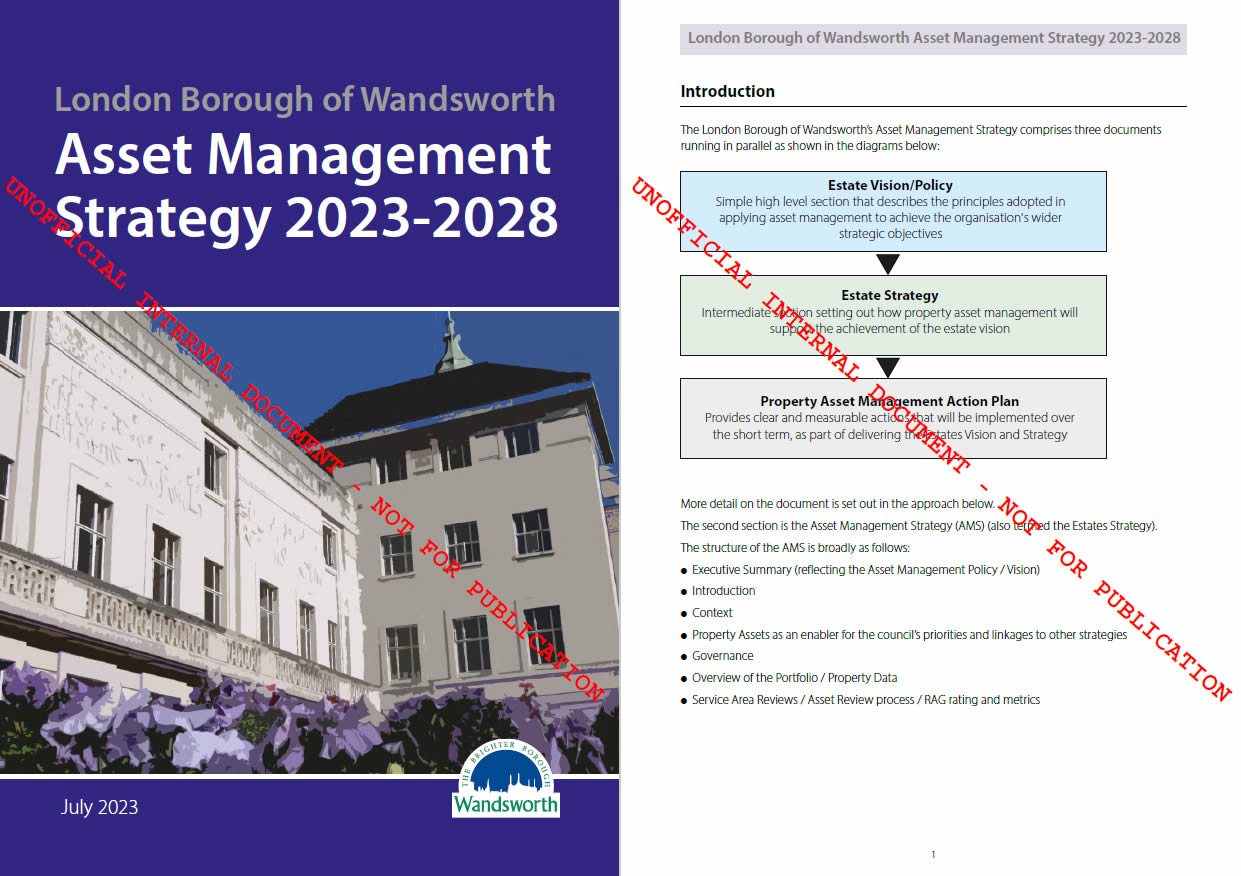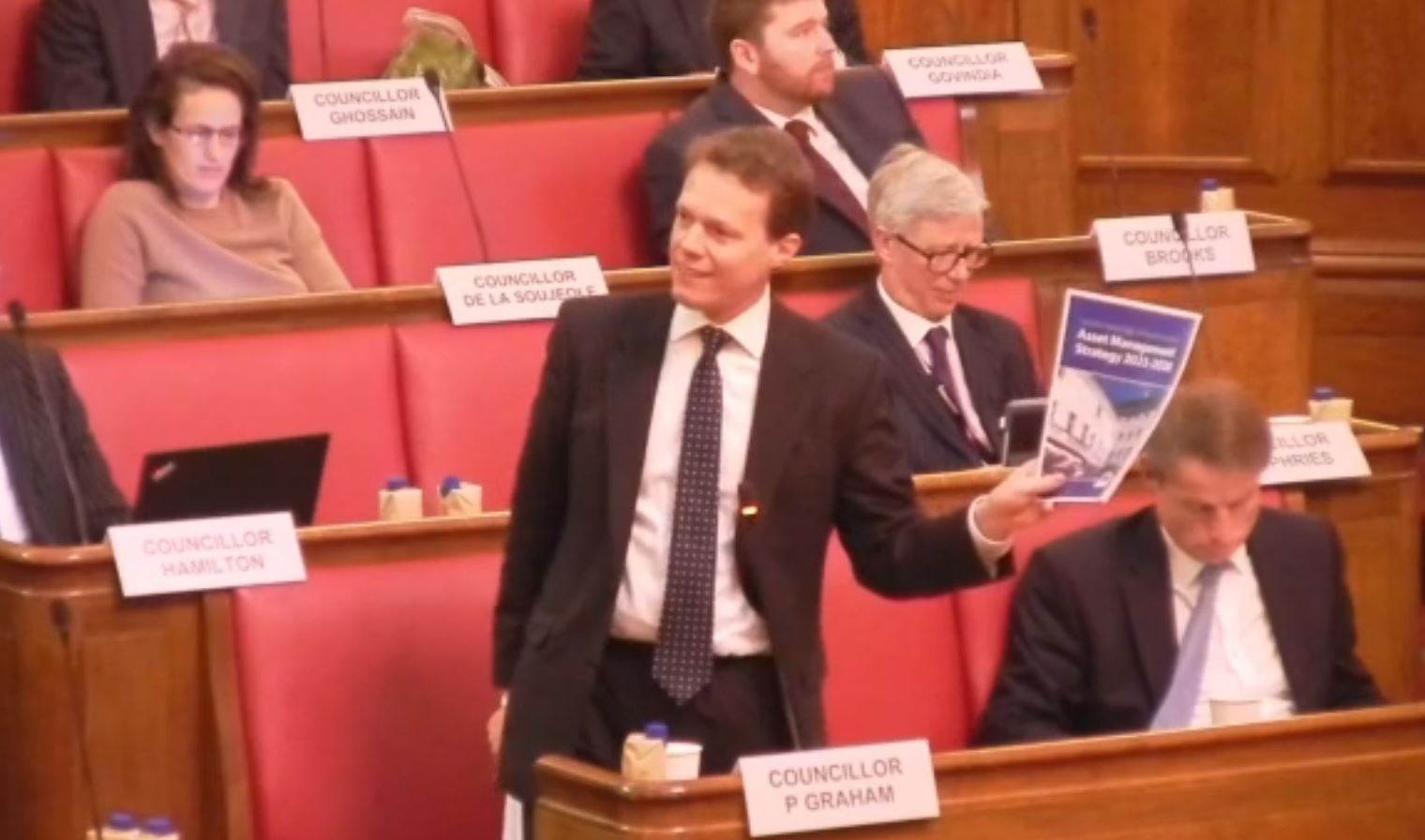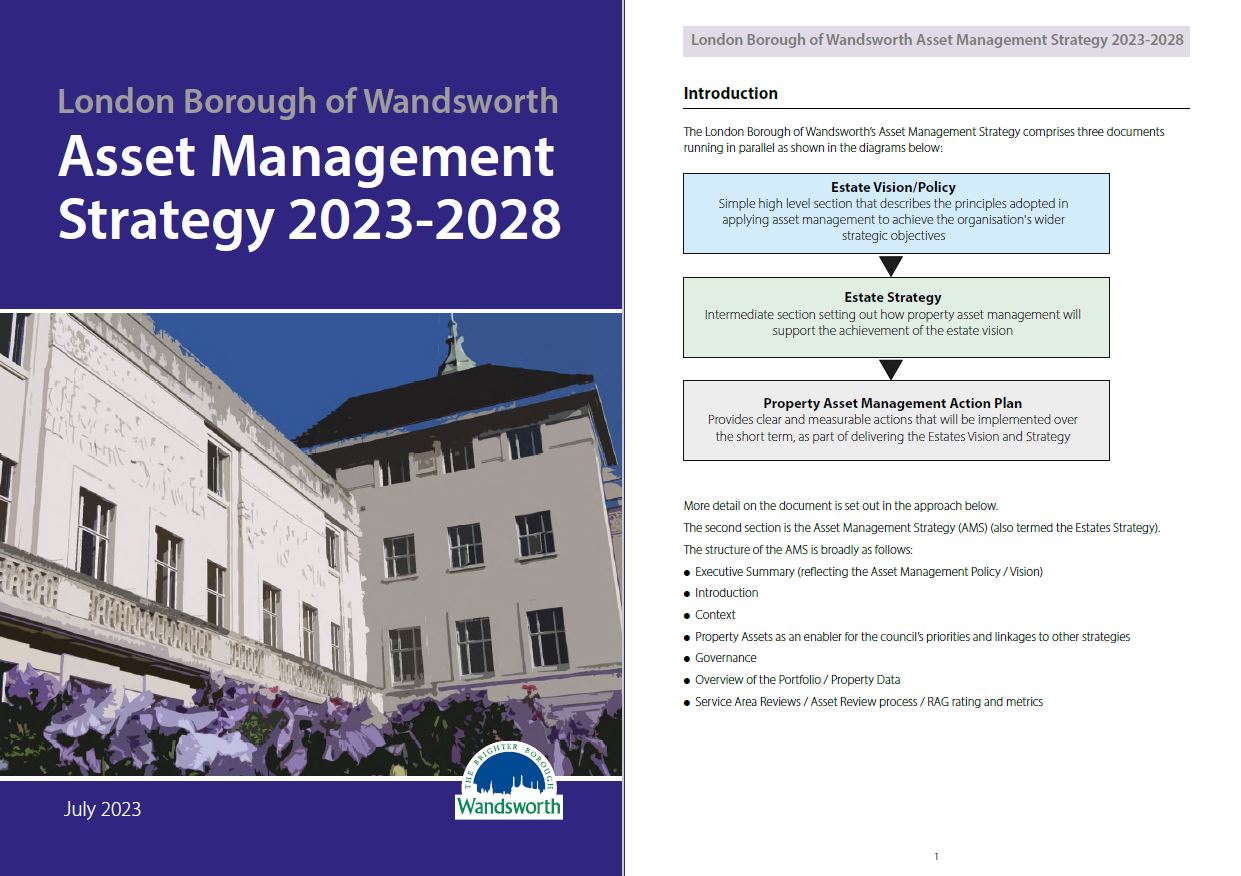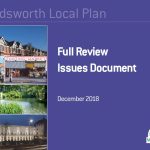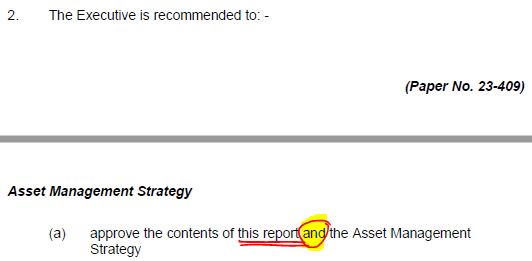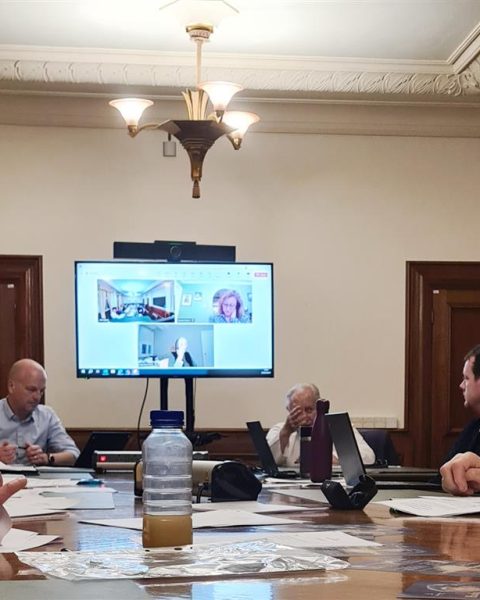The final Council meeting of 2023 was notably lively, particularly due to nearly 90 minutes being dedicated to the imbroglio surrounding the Asset Management Strategy document drafted by the Council, which the Labour administration continues to refuse to communicate and discuss in detail.
On several occasions, Councillor Sara Apps, Labour’s Chief Whip, attempted to interrupt the debate. She expressed to Cllr Graham, “We’re already bored, we’ve had enough of you,” and stated her desire to commence with the mince pies, even as the Mayor was attempting to allow Peter Graham to conclude his speech.
A mysterious report that Labour councillors refuse to communicate
One of the item on the agenda of the Finance Committee at the end of November 2023 was about the Asset Management Strategy (AMS).
Officers have received support from CIPFA Property in conducting a review of current asset management practices. CIPFA stands for the Chartered Institute of Public Finance and Accountancy, a UK-based organization for accountants that provides best practices and advice for the public sector where the management of public funds is required. A series of workshops with consultants was organized during the summer of 2022 and again in late 2022/early 2023, at a cost of £22,425 to the Council.
The AMS paper presented before the finance committee explained:
“The review has resulted in a number of recommendations which are set out below under themes of Data, Governance, Understanding Needs, and Sustainability. These recommendations form the basis of the Action Plan which will enable delivery of the Strategy over the 2023-28 period.”
David Sharp, the officer responsible for the strategic and operational management of the property portfolios for Richmond and Wandsworth Councils (including the valuation and asset management service) explained that a 37-page document called “London Borough of Wandsworth Asset Management Plan 2023-2028” was produced in July 2023 to support the document presented before the Finance Committee.
He said:
“It has formed the basis of this report. However, it was felt by officers that it was better to summarise that strategy on this basis rather than disclose that full report.”
Conservative Councillor Peter Graham pointed out the awkward absence of the background document used by the officers, particularly as Mr. Sharp indicated that the report presented before the finance committee was a summary of that document.
– Cllr Graham: Why has it not been listed as a background paper?
– Mr Sharp: Because officers have taken the view that they did not need to.
Labour councillor Belton commented that Cllr Graham was “pursuing a pedantic point which is not necessary and not really helpful and not moving the discussion forward” and that “we are not some copyright lawyer“. This seems to be part of the issue as Cllr Graham pointed out that it’s a matter of “compliance with the law“.
The Local Government Act 1972 is a UK legislation which explains, in paragraph 100D titled “Inspection and publication of background papers“, that each copy of the report must also have a list of the documents used to create it. In England, at least one copy of each document quoted must be available for the public to inspect at the council’s offices.
Jeremy Ambache, another Labour councillor, expressed that he was “hoping for more” in the paper presented before the Finance Committee, which, in fact, is exactly what the undisclosed report was doing, as pointed out by Cllr Graham.
Labour councillor Critchard, the chair of the committee, showed attempts to move to less controversial discussion, rolling her eyes in exasperation, provoking laugher when she said that if there is one more mention of “this other paper“, the discussion will end, and later raising her voice in an effort to regain control of the meeting.
A ‘secret’ document that resembles an official Council publication
A few of our readers reached out to us regarding the undisclosed report, particularly after a series of Tweets that Cllr Graham posted.
Despite our efforts to obtain information, some Labour Councillors steadfastly refused to provide us with the contentious document. We also submitted a Freedom of Information request in an attempt to acquire the document, but only received a response one and a half months later, and the answer merely included a link to the Committee report, as if they did not understand the question or the “London Borough of Wandsworth Asset Management Plan 2023-2028” dated July 2023 did not exist.
At this point, you are probably as eager as we were to see the famous ‘secret’ document. You can download it HERE.
The document resembles an official publication of Wandsworth Council. It underwent extensive efforts from the Wandsworth internal design team to produce a print-ready document, featuring dozens of bespoke images and graphics. The cost of designing the document was quoted at £1,938.
The layout is similar to many AMS documents published by other Councils and easily available. Below is an example from Eastleigh council.
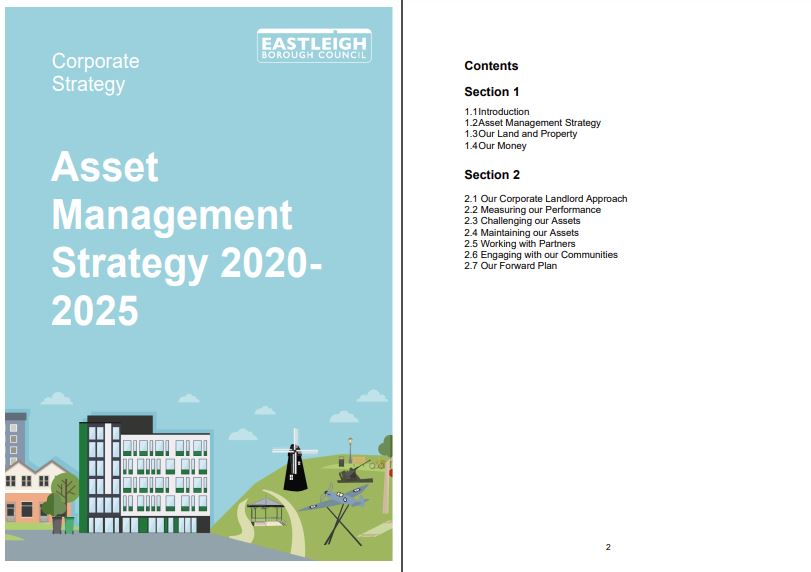
On page 5 of the document, it says:
“It is important that this AMS is published, so that residents but also wider stakeholders (e.g., local businesses, suppliers to the councils, community groups, other public bodies) can see and understand the council’s intentions. As above, this AMS is supported by best practice tools and techniques and by adequate staff capacity and capabilities. Finally, it is brought to life through some early project proposals.”
The brochure was produced before the review by the Finance Committee and endorsement by the Executive committee. However, this is a standard procedure as some documents are typically produced by the Council in a clean and easy-to-read format to be reviewed and consulted as drafts by the public before being labelled the “final version”.
As the matter progressed, the Labour administration did not address why the Council produced a print-ready design if the document was merely an internal officer paper. They stated on 7 February 2024:
“The document [London Borough of Wandsworth Asset Management Plan 2023-2028] is an internal officer paper and is not Council policy. The Council’s actual Asset Management Strategy was discussed at Finance Committee and was approved by the Executive.”
Below, you can see the different iterations and layouts of another Council document, the Local Plan, from the first draft to the final version. All of the steps are clearly communicated and publicly available on the Council website, but only the last document, named “Adopted version of the Local Plan 2023,” is the version approved by the Council and used as a reference for decisions.
While investigating the story for this article, we contacted a Labour councillor who stated that, although they had not seen the document, they suspected that the issue stemmed from work carried out by officers without the knowledge of the relevant Labour councillors. They told us:
“Officers might have thought they had the agreement of the Labour administration, while it was not the case.”
They added that their colleagues “don’t want to say they disagree with officers publicly” which, in this specific case, seems to make matter worse.
As a consequence, the Labour official line was to pretend that the report did not exist, claim they did not see the report, or dismiss its relevance for the final consideration of the Asset Management Strategy (AMS) as merely for internal use.
Even the wording of Paper No. 23-409 that went before the Finance Committee in November 2023, that officers might have failed to amend, implies that it was the case as it says: “The Executive is recommended to: – (a) approve the contents of this report and the Asset Management Strategy“.
As cllr Angela Ireland said that the “the paper 23-409 is the asset management strategy and that is what we we are discussing“, the sentence reads “approve the contents of this report and this report”, which is repeating twice the same thing. Either there is a spelling and English grammar mistake in the report, or there is a last minute change, no answer was provided.
What seems certain is that there is, here, a lack of focus at some point of the process.
Finally, is there any big concern to have with the Council’s strategy?
As the Committee report says:
“The purpose of an Asset Management Strategy is to provide a framework to help ensure that property assets are used to support these objectives. It
should enable informed decision making about the use of assets, using the available evidence. It should also enable the Council to take a joined-up,
corporate approach to the use of its property assets, enabling it to deliver best value for residents in the round.”
“If we had an asset management strategy that didn’t consider all assets and how all the assets of the council were used then we’d be criticized for not considering the totality of the council’s stock and considering whether they’re rightfully used. That’s what an Asset Management Strategy is about.”
The Council holds 219 operational properties with a total value exceeding £1.1 billion. This includes 1 museum, 66 schools, 11 libraries, 16 leisure centres, among others. An interesting comparison with other boroughs reveals that Wandsworth’s asset value is similar to that of Lewisham or Camden, but more than three times larger than Hammersmith & Fulham’s (although Wandsworth has double the population in the latter comparison).
The report labelled PAPER NO. 23-409 and presented as the Asset Management Strategy to the Finance Committee only presents aspirations and provides examples of “key service developments,” noting that most services are currently under review. These services include libraries, leisure facilities, mental health services, housing estate-based community centres and clubrooms.
The recommendations approved by the councillors (due to the controverse explained above, all Labour voted in favour against all Conservatives) include improving the data used, monitoring future maintenance costs, reviewing services, improving efficiency and refining requirements, and seeking opportunities around net zero and sustainability.
Overall, these recommendations reflect good intentions but do not provide any specific direction or commitments.
What about the accusation of intentions of selling libraries and community assets?
Since the imbroglio with the Asset Management Paper and the subsequent cover-up by the Labour Council, the Conservatives have been accusing the Labour administration of having intentions to sell off famous community assets such as the Doddington Activity Centre, the York Gardens Children Centre, or the Battersea Library.
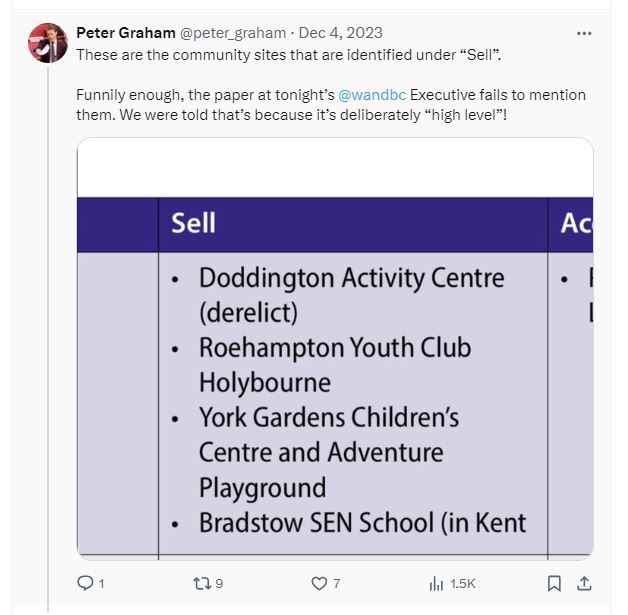
Initially, the refutation of the claim raised by the Conservatives was very mild, with Angela Ireland, Cabinet Member for Finance, responding to the question on whether there was an intention to sell Doddington Activity Centre, Roehampton Youth Club, York Gardens Children’s Centre and Adventure Playground and Bradstow SEN School with: “As far as I am aware, no” (which is different to simply: “no“).
This is a cautious comment, as indeed there might be valid reasons to review those assets. The full table that Cllr Graham was quoting shows also that there are proposals to acquire “around Leisure Centre”, and in some case it might be more efficient and better for the community to build a new facility rather than refurbish a derelict one.
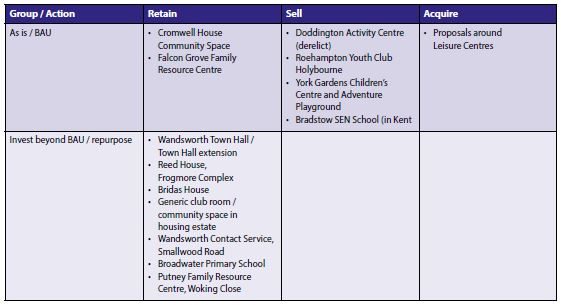
Asset Management
Strategy 2023-2028, July 2023
However, plans for the broader area encompass the construction of a 32-storey tower, contingent upon the current Council’s alignment with the Conservative agenda to expand the Clapham Junction/York Road skyline with additional skyscrapers. Within this redevelopment scheme, provision for a new Children’s Centre is likely to be included within the new buildings.
- Read our article: Community benefits to mitigate construction chaos on York Gardens
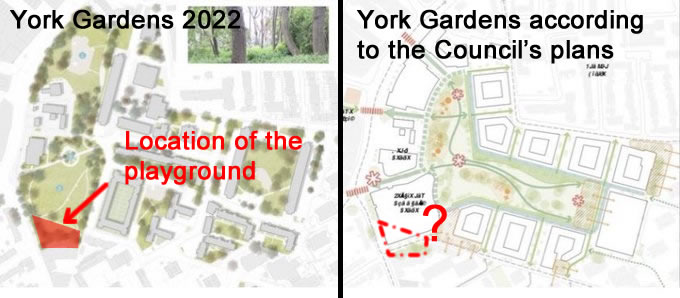
The Battersea Library was also mentioned as under threat by Cllr Graham on Twitter. This is obviously a very important community asset and (among the Battersea Art Centre) a very old building. Therefore it requires major maintenance that will need to be addressed subsequently, as the document points out. It is worth that due to the age of those buildings, they are noted are unlikely to achieve Net-Zero emission target and will need to be compensated by the council in other ways.
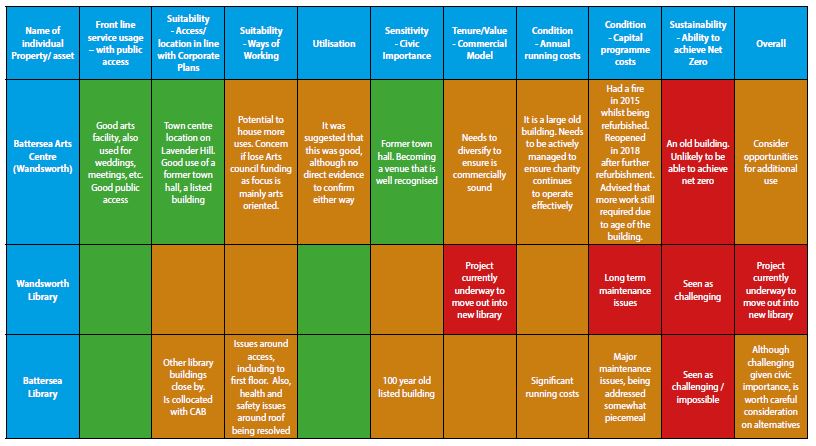
On page 24 of the document (and repeated page 30), it says (highlights in bold from CJI):
“It is important to stress that these actions, in particular sell; retain with investment; sell with investment; acquire then need to be the subject of a detailed business case, supported by hard evidence including running costs, condition, suitability, utilisation, etc.”
During the Finance Committee, Wandsworth Chief Executive Mike Jackson, said:
“Greater details will come forward in the more service specific actions and strategies that seat underneath. This strategy is meant to be very high level, at a level of principles.”
A politician once said: “Promises only bind those who believe in them“. However, there is a track record of past declarations from Labour Councillors regarding Community Centre or to save libraries (here is the mention of Cllrs Hogg and Belton regarding York Gardens library). And during the different Council meetings, the Labour administration has expressed a strong commitment to retaining community assets, affirming that there are no intentions to sell them.
Conclusion
The full story here is not about the options that the Council might explore to manage their assets. We showed above that there might be very good reasons to dispose or acquire new assets, in the benefits of the community. Issues on dealing with maintenance and sustainability also need to be addressed.
The concerning issue at hand is the Council’s approach to truthfulness and transparency, particularly when confronted with evidence. The Asset Management Strategy document, meticulously drafted by the Wandsworth Design team, was evidently intended for publication. With its comprehensive layout, abundant graphs, and illustrative photos, it was clearly designed to be accessible to residents, local businesses, council suppliers, community groups, and others.
However, instead of transparently publishing the document, the Labour administration chose to display a partial summary and bury it within obscure committee papers, only accessible through materials provided for the November 2023 Finance Committee meeting. When asked whether there will be a clearer document with more information, Mike Jackson, Wandsworth Chief Executive responded that there will be no further development to the AMS report and said: “It’s not the intention to revisit the strategy” and later “I’m not aware of any plan“.
The Leader of the Council, councillor Simon Hogg, declared in December, at the full Council meeting:
“If you want to know about our Asset Management Strategy, look it up on our website”,
This statement, unfortunately, underscores the evident challenges the Council faces in handling information and scrutiny, as a search on the Council website does not show the document.
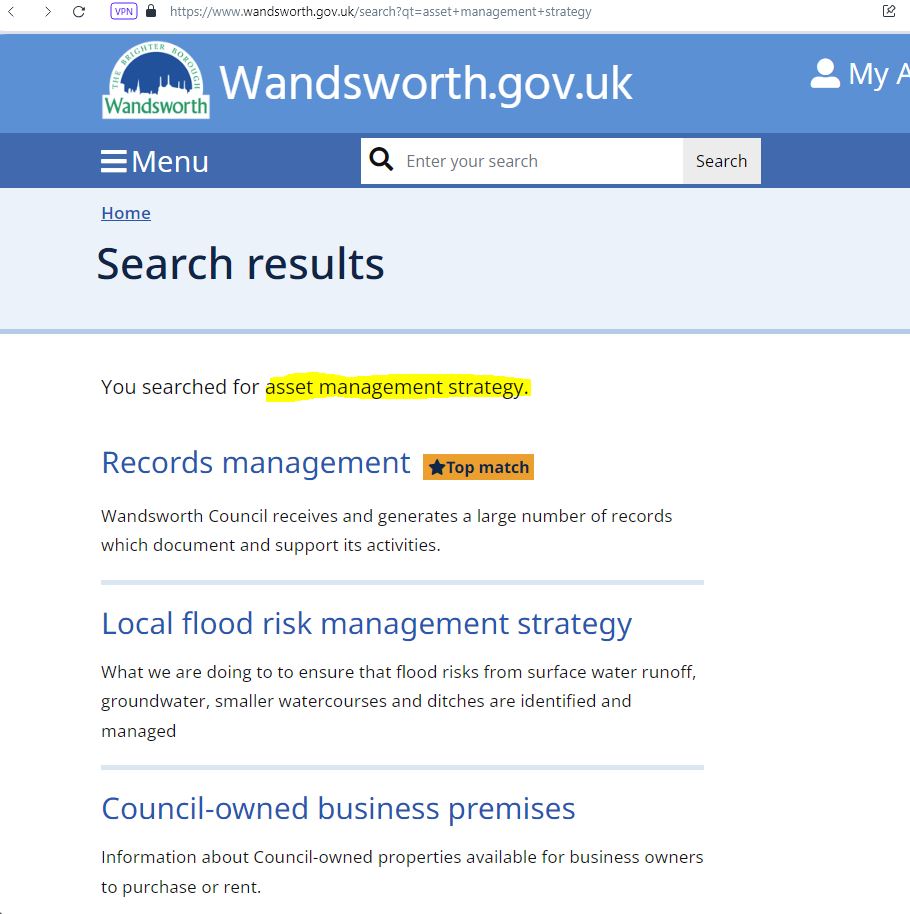
More Information…
Instead of the carefully chosen extracts displayed inside our article, you can watch the entire part dedicated to the Asset Management Strategy in the 30 November 2023 Finance Committee here:
You can also watch the (very long) part dedicated to the AMS in the Council meeting on 13 December 2023 here:
UPDATE 4/04/2024: Following a second Freedom of Information request asking for the document (in response to the first one, we only received the minutes of the Finance Committee), the Council sent us the correct document called Asset Management Strategy 2023-2028, June 2023 in a PDF format named Draft Strategy Version.pdf and labelled on all pages as: “UNOFFCICIAL INTERNAL DOCUMENT – NOT FOR PUBLICATION”. The content is the same as the one which was leaked.
